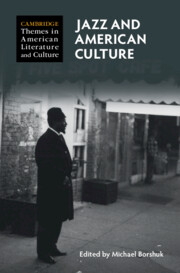Book contents
- Jazz and American Culture
- Cambridge Themes in American Literature and Culture
- Jazz and American Culture
- Copyright page
- Contents
- Contributors
- Acknowledgments
- Introduction
- Part I Elements of Sound and Style
- Part II Aesthetic Movements
- 5 Jazz Age Harlem
- 6 “Hard Times Don’t Worry Me”
- 7 A Fool for Beauty
- 8 Free Jazz, Critical Performativity, and 1968
- Part III Cultural Contexts
- Part IV Literary Genres
- Part V Images and Screens
- Bibliography
- Index
6 - “Hard Times Don’t Worry Me”
The Blues in Black Music and Literature in the 1930s
from Part II - Aesthetic Movements
Published online by Cambridge University Press: 09 November 2023
- Jazz and American Culture
- Cambridge Themes in American Literature and Culture
- Jazz and American Culture
- Copyright page
- Contents
- Contributors
- Acknowledgments
- Introduction
- Part I Elements of Sound and Style
- Part II Aesthetic Movements
- 5 Jazz Age Harlem
- 6 “Hard Times Don’t Worry Me”
- 7 A Fool for Beauty
- 8 Free Jazz, Critical Performativity, and 1968
- Part III Cultural Contexts
- Part IV Literary Genres
- Part V Images and Screens
- Bibliography
- Index
Summary
After the heavy saturation of blues performing in the 1920s and the application of various elements– rhythm, syncopation, call and response, lyrics, and so on– to avant-garde literature, Black and white, of the time, the country descended into a prolonged Depression in the 1930s. Blues recording ground nearly to a halt for several years, though conditions that fed into the blues were in ample supply. The music was changing with the amalgamation of swing band elements and boogie-woogie with the rural blues, producing a jumping hybrid that used blues structures and lyrics with a big-band lilt. The move to the Left, especially in the artistic community, found literary blues having a decidedly Leftist feel in writers such as Langston Hughes, holding over from the twenties and Frank Marshall Davis emerging in the thirties. There were still the musical artists from various genres, including classical, who made use of the blues, and movies, for example, reflected the music as well. It was a new kind of hot music– and thus, hot music literature– that was in the offing.
Keywords
- Type
- Chapter
- Information
- Jazz and American Culture , pp. 96 - 109Publisher: Cambridge University PressPrint publication year: 2023



